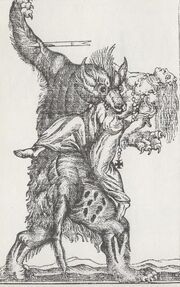
Werewolf mythology concerns the Lycanthrope, an ancient legend common in European folklore. Werewolves have become widespread icons and famous topics of fiction and popular culture.
mythology[]
In Proto-Indo-European mythology wearing the wolf was an aspect of initiation into the warrior class.
Some tribes believe they can merge with a spirit wolf. Tribals may done on wolf skins and furs in an attempt to reach altered states of consciousnes.
Skin-Walkers, or berserkers, where Wolf's clothing. They are thought to possess a wolf’s attributes (strength, feelings and personality) instead of their own.
Some legends say that the Werewolf is a sibling of the Devil. In medieval times, many people were killed and executed under accusations of being a Werewolf.
During the Witch trials many were accused of monstrous attacks and black magic. Witches were hanged and Wolves were killed.
The curse of the Werewolf is the supposed ability for a human to transform into a wolf or anthropomorphic wolf-like creature.
legends[]
The Greek myth of Lycaon is that he challenged Zeus by trying to serve him human flesh at a banquet. Zeus rained down thunder bolts and turned Lycaon and his sons into wolves.
The Beast Of Gévaudan was a man-eating wolf that plagued the town of its namesake. It was said to have claws, massive teeth and reddish fur and an unbearable odor. The Beast was killed by Antoine De Beauterne. Some legends say it was Werewolf.
Lycaon[]
Lycaon was the cruel king of Arcadia, son of Pelasgus and Meliboea, who tested Zeus by serving him a dish of a slaughtered and dismembered child in order to prove that Zeus was truly immortal. In his quest to test Zeus' immortality Lycaon attempted to murder the god while he slept.[1] In return for these gruesome deeds Zeus transformed Lycaon into the form of a wolf, and killed Lycaon's fifty sons by lightning bolts, except possibly Nyctimus, who was then the slaughered child, and instead became restored to life[2].
Bertrand[]
bertrand was a french werewolf whose first victem was a young woman. he hunted in france in 1871 and was killed by two convicts that used to work for the Confederate States of America and also a female french soilder.(he appeared in the mammoth book of wolfmen in a story called one paris night.)
Cry wolf[]
Andrew was a 15 year old werewolf that tourtured a town in italy. he became a werewolf after being bitten by one on December 1st 1871. he managed to kill alot of children and even a widow before getting killed by his father in december 21st 1872. (he appeared in the mammoth book of wolfmen in a story called cry wolf.)
claims[]
Some people say they are Werewolves, but most cases lead up to drug related issues or food poisoning.. Although it is possible to 'mind shift', as show below. Werewolves are popular since the 18th century, in the Old English.
etymology[]
The word Werewolf is most likely to have come from the Old English words wer (or were) and wulf. Wer translates into modern English as man (the gender meaning not race) and wulf is the ancestor to the modern English word wolf.
Other sources state that the word came from the word warg-wolf. The word warg is old norse for meaning outlaw or wolf and the wolf part is obviously modern English word wolf. (source citation needed)
Popular culture[]
- Modern Fiction
The werewolf legend is mentioned in a lot of modern stories:
- Silver Wolf
- The Werewolf's Vengeance
- The Night Of The Werewolf
- Twilight Saga
- TV
- Teen Wolf
- Wolfblood
- Hemlock Grove
- Supernatural
- The Vampire Diaries
- Movies
- The Wolfman
- An American Werewolf In London
- The Howling
- Underworld
- Van Helsing